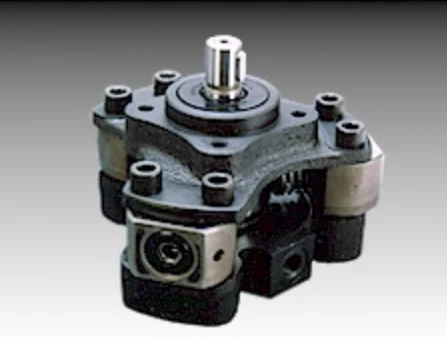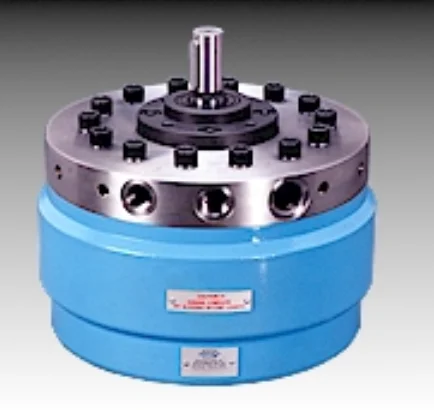Contact : +91-79045 61980 | Email: hydrofitengineers@gmail.com




Polyhydron Radial Piston Pumps
Radial piston pumps are a type of positive displacement pump that are commonly used in a variety of industrial applications. These pumps are designed to generate high-pressure flow rates by using them to compress fluid within a circular housing. They are known for their reliability, efficiency, and ability to operate in a wide range of temperatures and pressures.
Working principle of Radial Piston Pump
Radial piston pumps consist of several pistons that are arranged in a circular pattern around a central shaft. The pistons are driven by a cam or a swash plate, which rotates around the central shaft. As the pistons move in and out of their respective cylinders, they create a vacuum that draws fluid into the pump. The fluid is then compressed by the pistons as they move back towards the center of the housing. The compressed fluid is then expelled through an outlet port.
Advantages of Radial Piston Pumps
One of the main advantages of these pumps is their ability to generate high-pressure flow rates. Because the pistons are arranged in a circular pattern, they are able to compress fluid from multiple directions at once, which results in a more efficient and effective pumping action. This makes radial piston pumps ideal for applications that require high-pressure flow rates, such as hydraulic systems, oil and gas processing, and water treatment.
Another advantage of these piston pumps is their reliability. Because they are designed to operate in a wide range of temperatures and pressures, they are able to withstand harsh operating conditions without experiencing significant wear or damage. This makes them a popular choice for industrial applications that require high levels of reliability and uptime.
Why Use Radial Piston Pumps
Radial piston pumps are also known for their efficiency. Because they are positive displacement pumps, they are able to deliver a consistent flow rate regardless of changes in pressure or viscosity. This means that they are able to operate at high levels of efficiency even when pumping fluids that are thick or difficult to handle.
In addition to their efficiency and reliability,these hydraulic piston pumps are also easy to maintain. Because they are made up of a relatively small number of components, they can be disassembled and reassembled quickly and easily. This makes it easy to perform routine maintenance tasks such as changing the oil or replacing worn parts.
Types of Radial Piston Pumps
There are several different types of radial piston pumps available on the market, each with its own unique features and benefits. One common type is the fixed displacement pump, which is designed to deliver a fixed volume of fluid per revolution. These pumps are often used in applications where a consistent flow rate is required, such as in hydraulic systems or oil and gas processing.
Another type of piston pump is the variable displacement pump, which is designed to deliver a variable volume of fluid per revolution. These pumps are often used in applications where the flow rate needs to be adjusted based on changes in operating conditions, such as in water treatment or chemical processing.
There are also several different materials that can be used to construct radial piston pumps. Some pumps are made from metals such as steel or aluminum, while others are made from materials such as ceramics or composites. The choice of material will depend on the specific application and the operating conditions that the pump will be exposed to.
In conclusion, these piston pumps are an important type of positive displacement pump that are widely used in a variety of industrial applications. They offer a number of advantages over other types of pumps, including high-pressure flow rates, reliability, efficiency, and ease of maintenance. With their wide range of features and benefits, it is no wonder that radial piston pumps are such a popular choice for industrial applications around the world.
Different sizes of radial piston pumps
Radial piston pumps come in different sizes to accommodate a variety of flow rates and pressure requirements. The size of a radial piston pump is typically determined by the diameter of the housing and the number of pistons it contains. Some common sizes of radial piston pumps include:
Small radial piston pumps: These pumps typically have a diameter of less than 3 inches and contain fewer than 10 pistons. They are often used in applications that require low flow rates and moderate pressures, such as lubrication systems, small hydraulic systems, and machine tools.
Medium radial piston pumps: These pumps typically have a diameter of between 3 and 6 inches and contain between 10 and 20 pistons. They are often used in applications that require moderate flow rates and pressures, such as process control systems, injection molding machines, and hydraulic power units.
Large radial piston pumps: These pumps typically have a diameter of more than 6 inches and contain more than 20 pistons. They are often used in applications that require high flow rates and pressures, such as oil and gas processing, water treatment, and heavy equipment.
Custom radial piston pumps: In addition to standard sizes, radial piston pumps can also be custom-designed to meet specific application requirements. This can include modifications to the housing diameter, number of pistons, and materials used.
It is important to choose the correct size of radial piston pump for a particular application in order to ensure optimal performance and efficiency. Factors such as flow rate, pressure, fluid viscosity, and operating temperature should all be considered when selecting a pump size. Consulting with a pump manufacturer or a
We hereby declare that this video has been taken from the site of Techno AJ and we hold the content of this video in high esteem for the value that the same offers
